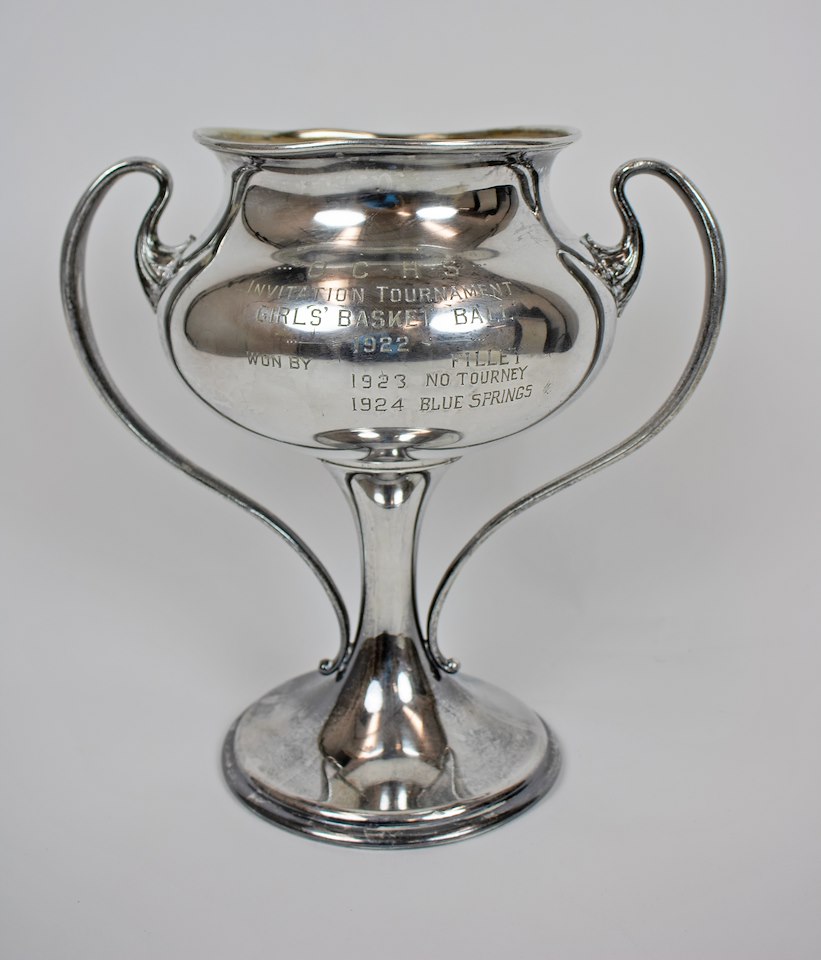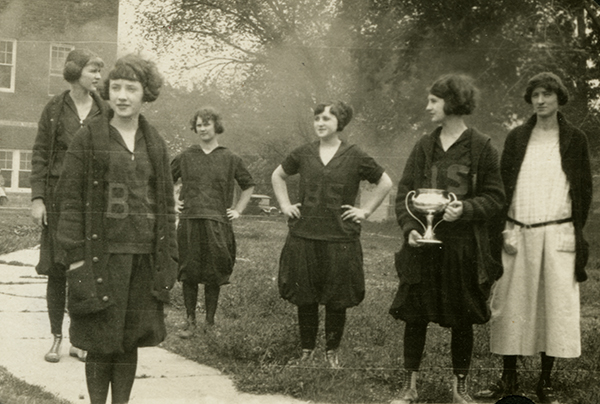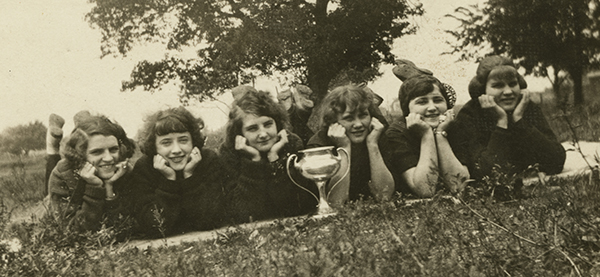
By David L. Bristow, Editor
Jim Brogden was browsing an estate sale in Acworth, Georgia, when he noticed this beautiful trophy. It tells a story not only of a basketball team, but also of a generation-long reaction against girls’ and womens’ sports.
Brogden bought the trophy and took it home. He knew nothing about it except the inscription:
O C H S
Invitation Tournament
GIRLS BASKET BALL
1922
Won by Filley
1923 No Tourney
1924 Blue Springs
An online search led him to a History Nebraska blog post, where he saw his trophy in a series of photos from Blue Springs, Nebraska. He wondered how a Nebraska basketball trophy made its way to Georgia, and he began to think that it belonged in a Nebraska museum. He soon donated it to History Nebraska. We have pieced together the story of the trophy and of the girls who won it.
OCHS stands for Otoe Consolidated High Schools, which hosted an invitational girls’ basketball tournament in Barneston on February 22-23, 1924. With “very snappy players, and team work to perfection” in the words of the Beatrice Express, Blue Springs defeated all their opponents to win the round-robin tournament. They even defeated a team from Hanover, Kansas, that had not lost a game in four years.[1]
With no shot clock and a jump ball after every basket, games were low-scoring affairs. Blue Springs defeated Barneston in the tournament final 15-12, but Barneston got its revenge later that season. In March, Blue Springs starting guard Lucile Davis broke her wrist in practice. She missed the season finale, in which Barneston defeated Blue Springs 8-7 and advanced to the state tournament. Blue Springs ended the season with a record of 17-2.[2]
Less than a month after the Otoe County tournament, the Nebraska High School Athletic Association voted to abolish the girls state basketball tournament after 1924 and to bar girls’ teams from entering any state, district, or county basketball tournaments in the future. Association members voiced “protests against girls’ competitive athletics in general.”[3]
The move was part of a long national backlash against women’s sports. The University of Nebraska had already disbanded its women’s basketball team (coached by the formidable Louise Pound) after the 1908 season. In 1924, the university hired Mabel Lee to head its women’s physical education department. Lee promoted intramural sports and recreation, but actively opposed all intercollegiate play. She believed that highly competitive, “mannish” play was harmful to women.[4]
Cornhusker women’s basketball was reintroduced as a varsity sport for the 1974-75 season. The Nebraska girls’ state high school basketball tournament resumed in 1977.[5]

History Nebraska RG3372-4-23
How did the trophy make its way to Georgia? Jim Brogden bought it at the estate sale of Stan Vasey. Brogden learned that Vasey was the son of the Vyral M. (Viets) Vasey of Wymore, Nebraska. We don’t know how or why she came to possess the trophy. Born in 1914, she was only ten years old at the time of the tournament, and she grew up and went to high school not at Blue Springs but at Union Center (between Wymore and Lewiston).[6]
What became of the Blue Springs players? The team consisted of guards Mabel Bolender, Iva Peck, and Lucile Davis, and forwards Helen Tays, Gladys Jenkins, Fern Lynxweiler. They are pictured here, but we have not yet been able to match names to faces.
We found no definite information on Lucile Davis, and limited information on Iva Peck Lawrence–all we know is that she lived in Omaha as of 1944, and in Montebello, California, in 1950.[7] But three of the remaining four lived exceptionally long lives.
Mabel Bolender Gerwick married and had at least two sons and lived her life in Gage County, dying in Beatrice at age seventy-six in 1983.[8]
Helen Tays Turnbull, married and was mother to six children, and worked at Sunrise Bakery in Beatrice. She died in Lincoln at age ninety-eight in 2005.[9]
Gladys Jenkins McPheron married, had a daughter, and worked as a teacher. She taught for sixteen years for the Department of Defense in Korea. She lived to be 100 years old, dying in Lincoln in 2006.[10]
Fern Lynxweiler Barker was the last surviving team member, dying in 2011 at age 103. Fern married, had two children, and worked as a legal secretary in Lincoln. Her obituary noted that she became a world traveler and was honored for her extensive volunteer work at Bryan-LGH Medical Centers in Lincoln. The obituary also identifies her as “a standout on the Gage County girls’ championship basketball team.” The story of the Blue Springs team was still being told proudly into the twenty-first century.[11]
We can only imagine what the former Blue Springs players thought in the 1970s when their granddaughters’ generation saw the revival of the girls’ state basketball tournament and the growth of opportunities for female student athletes under Title IX. They may have wondered why it took so long.

History Nebraska RG3372-4-26
This story also appears in the Spring 2023 issue of Nebraska History Magazine. Subscribe by becoming a History Nebraska member.
Update, 3/27/23: Mabel Bolender’s granddaughter, Shirley Morris, contacted us and identified her grandmother as the girl on the right in the second photo. (And thus, back left in the first.)
[1] “Neighborhood News,” Beatrice Daily Express, Feb. 29, 1924.
[2] “Barnston Girls Are Champion Basketeers of Southern Gage Towns,” Beatrice Daily Express, March 13, 1924; “Blue Springs Girls Wind Up Good Season,” Beatrice Daily Express, March 19, 1924.
[3] Gregg M’Bride, “State Basketball Tourney, Largest in World, Is Legislated Out of Existence,” Omaha World-Herald, March 14, 1924, 14.
[4] Kristi Lowenthal, “Mabel Lee and Louise Pound: The University of Nebraska’s Battle over Women’s Intercollegiate Athletics” (M.A. Thesis, University of Nebraska-Lincoln, 1999), 8.
[5] Dirk Chatelain, “Happy 50th birthday, Nebraska girls basketball,” Omaha World-Herald, April 15, 2022.
[6] “Vyral M. Vasey” (obituary), Beatrice Daily Sun, July 3, 2010.
[7] “Alumni Banquet Held Thursday Eve, May 18,” Blue Springs Bee, May 25, 1944; “Services Monday,” Wymore Arbor State, Dec. 21, 1950.
[8] “Mabel Irene Bolender, 24 April 1907–21 May 1983,” FamilySearch, https://ancestors.familysearch.org/en/L98T-8LL/mabel-irene-bolender-1907-1983
[9] “Helen Thema (Tays) Turnbull” (obituary), Beatrice Daily Sun, March 12, 2005.
[10] “Gladys McPheron,” Beatrice Daily Sun, Aug. 14, 2006.
[11] “Nebraska Obituary and Death Notice Archive – Page 532,” https://www.genlookups.com/ne/webbbs_config.pl/noframes/read/532




